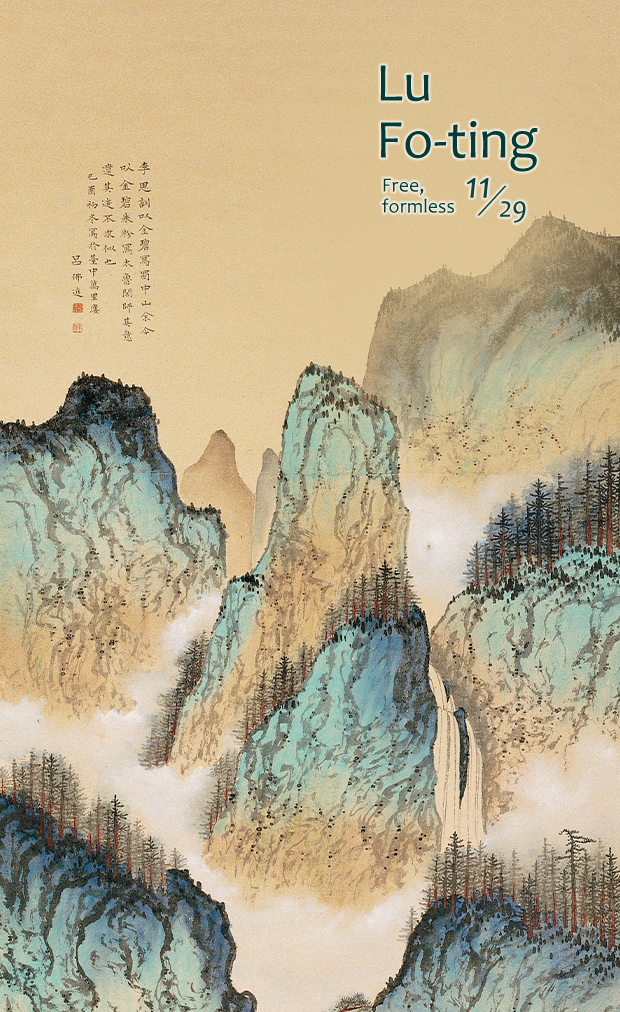

Lu Fo-ting (1911-2005) was born on Oct. 19, 1911, in Miyang County in China's Henan Province. Although his given name was Fu-ting, his family called him Tian-ci as a child, meaning "bestowed by Heaven." The pull of Buddhism as a young man led him to change his name to Fo-ting, using the character fo for "Buddha." Professionally he took the names Pan-tseng ("incomplete monk") and Yu-wong ("old windbag"), but was widely known as Fo-ting during his career.
From an early age, Lu was fond of the zither, poetry, painting and calligraphy. Born into a family of doctors, he studied calligraphy with his father from the age of five, could recite poetry by the age of six, studied bird-and-flower painting at eight and learned how to compose poetry at 12. When he was 15, he entered a Christian high school, where he first came into contact with Western art through figurative painting and learning how to paint the female form.
In 1931, he entered the National School of Fine Arts (present-day Central Academy of Fine Arts) in Beijing to study Western art in the School of Fine Art, but later transferred to the School of Chinese Painting. Here, he studied with numerous renowned artists, including Qi Baishi and Qin Zhongwen, building a firm foundation in the discipline while also developing his own path.
Lu held his first solo exhibition in Beijing in 1934, and the following year founded a painting and calligraphy research society with his friends. In 1937, after the Marco Polo Bridge Incident, he formed a society selling paintings to support the national war effort against Japan. In 1944, he exhibited 80 paintings in Lushan, Xi'an, Chengdu and Chongqing from a new series depicting famous generals throughout history to boost morale.
After moving to Taiwan in 1948, Lu taught at a number of schools, including the Taiwan Provincial Taichung Normal School (present-day National Taichung University of Education), the fine arts department of the Taiwan Provincial College of Education (present-day National Taiwan Normal University), the arts department of the National School of Arts (present-day National Taiwan University of Arts) and the Fine Arts Institute at Chinese Culture University. He devoted his life to arts education, founding the Central Taiwan Fine Arts Association and the Kuofeng Chinese Painting Society, and sitting on national and provincial arts committees and Ministry of Education arts review committees. Throughout his life he received numerous awards, including the first Chung Shan Arts Award, the National Award for Arts and the Ministry of Education First Culture Award, adding to his many achievements other in the arts.
In painting, Lu is primarily known for his landscapes. As a child, he copied from the Jieziyuan Huapu (Manual of the Mustard Seed Garden) and the old masters, using the past as his guide. Inspired by the teacher Xu Xiangjie during his time at the National School of Fine Arts in Beijing, he began his studies by looking at works from the Five Dynasties period and Northern Song landscapes, laying the foundations for the formation of his own style.
Inspired by Xu Xiake's advice to "read 10,000 books and walk 10,000 miles," he travelled extensively in China after graduation, visiting important scenic spots and sketching his thoughts along the way. In 1946 he published these jottings and drawings as Shudao Wanli Ji (Notes from Travels in Sichuan) and Shudao Wanli Tu (Sketches from Travels in Sichuan).
After coming to Taiwan, he completed four major scrolls within eight years — Changcheng Wanli Tu (Travels Along the Great Wall), Changjiang Wanli Tu (Travels Along the Yangtse River), Huanghe Wanli Tu (Travels Along the Yellow River) and Henghuan Wanli Tu (Travels Along the Cross-Island Highway) — an achievement that brought him much attention.
In 1971, Lu used pre-imperial pictographs from ancient oracle bone and bronze inscriptions to develop "character paintings," in which he combined early Chinese characters to create drawings that were at once calligraphy and painting, emphasizing the beauty of the lines. He also used the splashed ink technique to create Zen art, striving for an idea realm devoid of intentionality or form. In calligraphy, Lu excelled in standard script, having learned the forms developed by the Tang Dynasty calligraphers Ouyang Xun and Yan Zhenqing from his father and father-in-law, Zhang Songzhai, as well as Han clerical script after an introduction from Zhang Xubin during art school. These studies gave him a firm foundation from which to develop his own unique style, the Lu script, which combines standard and clerical forms. He perfected the script in 1960 by incorporating the style of the Diamond Sutra carved into the rock face of Mt Tai, known as the Taishan Jingang Jing (Diamond Sutra on Taishan), to create a rounded, simple form.
In addition to his painting and calligraphy, Lu composed poetry, played the zither and studied Zen thought. He also conducted extensive research into the history and theory of Chinese art, authoring many books with titles including Zhongguo Shuhua Yuanliu (The Origins of Chinese Painting and Calligraphy), Zhongguo Huashi Pingzhuan (On the History of Chinese Painting), Zhongguo Huihua Sixiang (On Chinese Art), Wenzihua Yanjiu (Studies on Character Paintings) and Jiangshan Wanli Lou Shiji (Poetry Collection on Chinese Landscapes), making him one of the few Chinese artists of his generation to have excelled as both an artist and a researcher.
